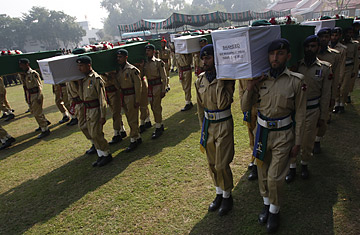
Pakistan army soldiers carry coffin of Saturday's NATO attack victims for funeral in Peshawar, Pakistan on Sunday, Nov. 27, 2011.
(2 of 2)
At this point, Nadeem said, messages had been relayed up the Pakistan army's chain of command. After speaking with Lieut. General Asif Yasin Malik, the Peshawar Corps commander, Nadeem said that he spoke with an International Security Assistance Force (ISAF) commander in Afghanistan and asked that the NATO helicopters stop firing.
Soon after 1 a.m., the Pakistani army says, the NATO helicopters "pulled back." During this interval, more Pakistani troops rushed out from a second company headquarters to reinforce the two border posts. Major Mustafa was one of the officers who ventured out and later told the senior generals that firing from the NATO helicopters resumed at that point for a second time. The Pakistani army says it doesn't understand why the NATO helicopters began firing again, about 15 minutes after having pulled back. They characterized NATO's actions as "intermittent attacks." In retaliation, the Pakistani troops fired "26 rounds of artillery air bursts."
They were intended as "warning fire," Nadeem said. He added that the military does not know if any of the NATO helicopters suffered any damage from the shrapnel released by the airbursts of artillery fire. This second exchange of fire ended at 2:15 a.m., according to the Pakistani army's account. At that time, communication was re-established with NATO, and the two border posts had been destroyed. Nadeem showed the journalists a high-definition video of the destruction.
Other questions that hang in the air include why the joint NATO-Pakistan mechanism for border control broke down. The standard operation procedure, the Pakistani army explained, is for both sides to inform each other in advance if they are going to be carrying out a military operation within 10 km of the Afghanistan-Pakistan border. This is especially true for the last two kilometers on either side of the border, considered very sensitive territory. When operations are planned, the other side is supposed to be responsible for blocking the escape route of any militants in a hammer and anvil action. (In an earlier account of the incident given to TIME, a senior Pakistani military official said the army had received notification that NATO was carrying out a military operation near its side of the border.)
As part of the agreements on border control, if one side comes under fire, it is supposed to immediately inform the other side. At that point, Nadeem explained, it becomes the responsibility of the side that is firing to stop immediately.
Many observers hope that the investigation being carried out by U.S. Central Command (CENTCOM) will provide answers to the lingering questions. CENTCOM is expected to present its findings by Dec. 23, and NATO, the Afghan government and the Pakistani government have all been asked to provide representatives to the investigating team.
But the Pakistanis seem to have already made up their minds and say they have no expectations from the CENTCOM investigation. "The contention that it was unintended defies logic and professional military judgment," Nadeem told the briefing in a brusque reply to NATO's earlier pleas for understanding.
The Pakistanis are so irate that they have decided to boycott the forthcoming international security conference on Afghanistan in Bonn, Germany, despite appeals from Afghan President Hamid Karzai and German Chancellor Angela Merkel. The NATO supply routes to Afghanistan are still closed. If they remain so for 30 days, NATO forces will find it particularly difficult to obtain the fuel they need. The routes from Karachi are their only supply line for fuel.
But at the briefing, Nadeem said there are limits to how far Pakistan can push the U.S. and NATO. "Given the technology, we can't fight them," he said. There were moments when the Pakistani generals said they had to "consider whether we wanted to climb the escalatory ladder." In the end, they balked at taking more aggressive measures that they would find it difficult to pull back from.
